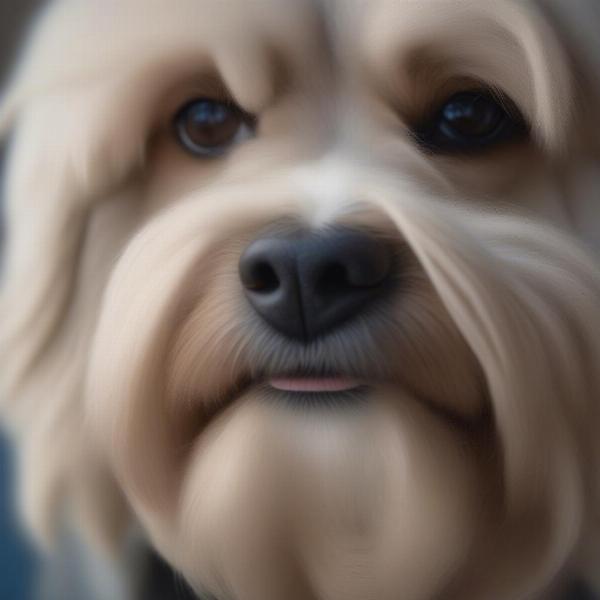Wool coat dogs are known for their distinctive, soft, and often hypoallergenic coats. This comprehensive guide will delve into the world of wool coat dogs, covering breeds, care requirements, health considerations, and tips for maintaining their luxurious fleece. Understanding the specific needs of these unique canines will ensure they remain healthy, comfortable, and looking their best.
Understanding the Wool Coat
Unlike typical dog fur, a wool coat is more similar to sheep’s wool. It’s crimped and dense, providing excellent insulation against both heat and cold. This unique texture often makes wool coats less likely to trigger allergies, making them a popular choice for sensitive individuals. However, this dense coat requires specific grooming techniques to prevent matting and maintain its health.  Close-up of a dog with a wool coat
Close-up of a dog with a wool coat
Popular Wool Coat Dog Breeds
Several breeds boast this unique coat type. Some of the most popular include:
- Poodles: Known for their intelligence and elegance, Poodles come in three sizes: Standard, Miniature, and Toy.
- Bichon Frise: These small, cheerful dogs are known for their playful personalities and fluffy white coats.
- Lagotto Romagnolo: This Italian breed was originally bred for water retrieving and has a distinctive, curly wool coat.
- Portuguese Water Dog: Another water-loving breed, the Portuguese Water Dog has a thick, waterproof wool coat.
- Soft Coated Wheaten Terrier: This Irish breed has a silky, wavy wool coat that requires regular brushing.
Grooming a Wool Coat Dog
Maintaining a wool coat requires a commitment to regular grooming. Here’s a breakdown of essential grooming practices:
- Brushing: Daily brushing is crucial to prevent mats and tangles. A slicker brush or a comb specifically designed for wool coats works best.
- Bathing: Bathe your wool coat dog every 4-6 weeks, using a gentle, hypoallergenic shampoo and conditioner formulated for dogs.
- Professional Grooming: Consider professional grooming every 6-8 weeks. A groomer can provide expert clipping, trimming, and de-matting services.
- Drying: Thoroughly dry your dog’s coat after bathing to prevent matting and skin irritation. A hairdryer on a low heat setting can be used, but be cautious not to burn the skin.
Health Considerations for Wool Coat Dogs
While wool coats offer many benefits, they also present unique health considerations:
- Matting: Neglecting regular brushing can lead to painful mats, which can restrict airflow to the skin and cause irritation.
- Skin Infections: The dense coat can trap moisture, creating a breeding ground for bacteria and yeast, leading to skin infections.
- Parasites: Wool coats can harbor fleas and ticks, making regular parasite prevention crucial.
Are Wool Coat Dogs Truly Hypoallergenic?
While no dog breed is completely hypoallergenic, wool coat dogs produce less dander, the primary allergen in dog saliva and skin flakes. This makes them a better choice for many allergy sufferers. dog sweaters french bulldog
Choosing the Right Wool Coat Dog for You
Choosing a dog should be based on more than just coat type. Consider your lifestyle, living situation, and experience with dogs. Research different breeds and talk to reputable breeders or rescue organizations. chihuahua dog coats
What is the best brush for a wool coat dog?
A slicker brush or a metal comb specifically designed for de-matting are excellent choices for wool coat dogs.
How often should I bathe my wool coat dog?
Bathing your wool coat dog every 4-6 weeks is generally sufficient. bulldog jumpers for dogs
Can I shave my wool coat dog?
While you can shave a wool coat dog, it’s generally not recommended as it can alter the texture and protective qualities of the coat. pitbull sweaters for dogs
What are the signs of a skin infection in a wool coat dog?
Redness, itching, hair loss, and a foul odor are common signs of skin infections in dogs.
What are some tips for preventing matting in a wool coat dog?
Daily brushing, regular professional grooming, and thorough drying after baths are essential for preventing matting. free crochet patterns for dogs
Conclusion
Wool coat dogs offer unique companionship and require specific care to thrive. By understanding their grooming needs and potential health concerns, you can ensure a long, happy, and healthy life for your woolly friend. Remember, regular grooming is key to maintaining their beautiful coat and overall well-being.
1. What are the benefits of a wool coat on a dog?
Wool coats provide excellent insulation, are often hypoallergenic, and have a distinctive, soft texture.
2. What are some common wool coat dog breeds?
Poodles, Bichon Frises, Lagotto Romagnolos, and Portuguese Water Dogs are common wool coat breeds.
3. How do I groom a dog with a wool coat?
Daily brushing, regular bathing, and professional grooming are essential for maintaining a wool coat.
4. Are wool coat dogs truly hypoallergenic?
While no dog breed is completely hypoallergenic, wool coat dogs produce less dander, making them a better choice for some allergy sufferers.
5. What health issues can affect wool coat dogs?
Matting, skin infections, and parasites are potential health concerns for wool coat dogs.
ILM Dog is your dedicated resource for all things canine. We offer expert advice on dog breeds, health, training, nutrition, grooming, and much more. Whether you’re a seasoned dog owner or just starting your journey, ILM Dog is here to help. Contact us today for personalized support: Email: [email protected], Phone: +44 20-3965-8624. Visit us at ILM Dog for a wealth of information and resources to help you provide the best possible care for your furry friend.